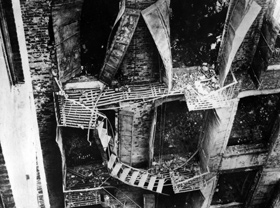WARNINGS
Part One, Chapter Two (excerpt), page 26
Nine days before the Triangle Fire-on March 16-the New York Call published excerpts from the report of Dr. George M. Price, the [New York Joint Board of Sanitary Control's] director. Copies of the full report on the investigation had already been sent to the Building, Fire, and Police Departments. In addition, the Board's secretary, Henry Moskowitz, had sent a long list of shops with hazards to Mayor William J. Gaynor.
Dr. Price noted that the coat and suit shops were not the worst offenders in the matter of safety. "Yet," he declared, "our investigation into the conditions in these shops clearly shows that fire prevention facilities are very much below even the most indispensible [sic] precautions necessary."
Ninety-nine per cent of the shops were found to be defective in respect to safety: 14 had no fire escapes; 101 had defective drop ladders; 491 had only one exit; 23 had locked doors during the day; 58 had dark hallways; 78 had obstructed approaches to fire escapes; and 1,172, or 94 per cent, had doors opening in instead of out.
Only one had ever had a fire drill.
But at Triangle there had been a warning. In 1909, when the firm was adding to its insurance coverage, P.J. KcKeon, an expert and lecturer on fire prevention at Columbia University, was commissioned to make an inspection of the shop.
He was concerned immediately with the crowding of so many people into the top three floors of the building. Upon inquiring, he learned that the firm had never held a fire drill. He noted that without previous instruction on how to handle themselves in such an emergency a fire would panic the girls.
McKeon found that the door to the Washington Place stairway was "usually kept locked," and was told this was because "it was difficult to keep track of so many girls." He thought he had impressed management with the need to hold fire drills. Accordingly, he recommended that Mr. H.F.J. Porter, one of the ablest fire prevention experts in the city, be called in to set up the drills.
On June 19, 1909, Porter wrote to Triangle at McKeon's suggestion, offering to call at management's convenience. He never received a reply to his letter.
There were other portents.
Exactly four months before the Triangle tragedy-on November 25, 1910-fire broke out in an old four-story building at Orange and High Streets in Newark, New Jersey. In minutes, twenty-five factory workers, most of them young women, were dead. Of these six were burned to death, nineteen jumped to death.
The disaster just across the Hudson River shocked New York and the next day Chief Croker warned:
"This city may have a fire as deadly as the one in Newark at any time. There are buildings in New York where the danger is every bit as great as in the building destroyed in Newark. A fire in the daytime would be accompanied by a terrible loss of life."
Professor Francis W. Aymar of the New York University Law School read Chief Croker's warning. He immediately wrote a letter to the city Building Department saying that from the windows of his classroom he could see the crowded and dangerous conditions in the Asch building across the yard. His letter was acknowledged and assurance of an investigation was given.
Following the Newark fire, the Women's Trade Union League assigned Miss Ida Rauh to study the disaster and draw up a set of conclusions and recommendations. This she did and then, on behalf of the League, Miss Rauh wrote to the January Grand Jury asking to be heard.
Her hearing was short, and fruitless. She was practically dismissed by the foreman of the Grand Jury when she had identified herself. He warned her that "unless you have a complaint of criminal negligence on the part of an official, you had better take your stories to the Corporation Counsel and have him prosecute for violations.
The lesson of the Newark fire was not lost on Alderman Ralph Folks. He introduced a resolution in the Board calling on the Superintendent of the Building Department to investigate and determine if additional legislation were needed to protect the lives of factory workers in New York. Four months before the Triangle fire the resolution was passed.
The day after the Asch building disaster, the Times sought out Alderman Folks and asked him what had come of the investigation he had requested in his resolution.
"I don't know. I never heard of it again, "he replied.
The Times also found Mr. H.F.J. Porter, who had written to Triangle for an appointment on the matter of fire drills.
"There are only two or three factories in the city where fire drills are in use," he declared ruefully. "In some of them where I have installed the system myself, the owners have discontinued it.
"The neglect of factory owners in the matter of safety of their employees is absolutely criminal. One man whom I advised to install a fire drill replied to me: 'Let 'em burn. They're a lot of cattle, anyway.' "
Leon Stein, The Triangle Fire (New York: A Carroll & Graf/Quicksilver Book, 1962), pp. 26-28.
The Kheel Center would like to thank Mrs. Miriam Stein and Barbara Ismail for granting permission to use selections from the late Leon Stein's book.

